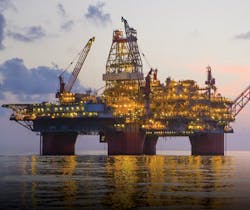Gulf of Mexico
Bruce Beaubouef • Houston
BP starts up latest Thunder Horse expansion project
BP has started up the Thunder Horse Northwest Expansion project in the deepwater Gulf of Mexico, four months ahead of schedule and 15% under budget.
Originally planned for start-up in early 2019, the project adds a new subsea manifold and two wells tied into existing flowlines 2 mi (3.2 km) north of the Thunder Horse platform. First oil was achieved 16 months after being sanctioned.
The new project is expected to boost production at Thunder Horse by an estimated 30,000 boe/d at its peak, taking gross output to more than 200,000 boe/d.
“This latest expansion of Thunder Horse is another important milestone in our efforts to maximize value from our assets in the Gulf,” said Starlee Sykes, regional president of BP’s Gulf of Mexico and Canada business. “Over the past five years we’ve driven up production through safe and reliable operations and bringing on new deepwater projects in a more efficient and standardized way. All this hard work is now delivering results. Our Gulf of Mexico business is thriving.”
BP says that its Thunder Horse Northwest Expansion project adds a new subsea manifold and two wells tied into existing flowlines about two miles north of the Thunder Horse platform.(Courtesy BP)
It comes after two other major field expansions at Thunder Horse in recent years. In 2017, an expansion of Thunder Horse’s south field – a four-well tieback to the floating hub – boosted gross production at the field by more than 50,000 boe/d. In 2016, BP started up a major water injection project at Thunder Horse to further enhance oil production at the field.
Developed with partner ExxonMobil, the Thunder Horse platform is in more than 6,000 ft (1,829 m) of water and began production in June 2008. It has the capacity to handle 250,000 b/d of oil and 200 MMcf/d of natural gas (gross).
BP’s net average daily production in the Gulf of Mexico has increased from less than 200,000 boe/d in 2013 to more than 300,000 boe/d and is set to grow further with the addition of the Mad Dog Phase 2 platform in 2021 and other upcoming projects.
Petrobras, Murphy to form joint venture
Murphy Exploration & Production Company-USA has entered into a definitive agreement to form a new joint venture company with Petrobras America Inc. (PAI).
Both companies will contribute all their current producing Gulf of Mexico assets to the joint venture, which will be owned 80% by Murphy and 20% by PAI. The transaction excludes exploration blocks from both companies, except for PAI’s blocks that hold deep exploration rights. The transaction is expected to close by the end of the year.
Murphy will pay cash consideration of $900 million to PAI, subject to normal closing adjustments. Additionally, PAI will earn an additional contingent consideration up to $150 million if certain price and production thresholds are exceeded beginning in 2019 through 2025. Also, Murphy will carry $50 million of PAI costs in the St. Malo field if certain enhanced oil recovery projects are undertaken. Upon closing, Murphy expects to fund the transaction through a combination of cash-on-hand and the company’s senior credit facility.
Petrobras said that the joint venture will have an estimated average production of 75,000 boe/d in 4Q 2018, and will comprise the following assets:
• Deepwater fields: Cascade, Chinook, St. Malo, Lucius and Hadrian North, Cottonwood, Hadrian South, Dalmatian, Front Runner, Clipper, Habanero, Kodiak, Medusa and Thunder Hawk.
• Shallow-water fields: South Marsh Island 280, Garden Banks 200/201 and Tahoe.
ExxonMobil reportedly considers
divesting assets
ExxonMobil is reportedly considering divesting a number of its US Gulf of Mexico oil assets, according to multiple sources.Sources familiar with the matter were quoted by Reuters as saying that the sale plan is the result of the US-based ExxonMobil’s review of its portfolio. Expected to take place in 2019, the sale would enable the company to concentrate on offshore areas such as Guyana and Brazil and onshore in the Permian basin of Texas.
According to Reuters, a few companies have been approached by ExxonMobil to determine their ‘potential interest’ in acquiring the oil assets. The sale could include the disposal of deepwater assets in the Gulf of Mexico that produce nearly 50,000 b/d of oil.
An ExxonMobil spokesperson told Reuters: “ExxonMobil continually reviews its assets for their contribution toward meeting the company’s operating needs, financial objectives and their potential value to others. We remain committed to conducting business in the US Gulf region, as we have for more than 100 years.”
The company’s assets in the Gulf of Mexico include the Julia oil field and Hadrian South natural gas field in which it owns 50% and 46.7% stakes, respectively. It also holds 9% of Heidelberg field and 23.3% of the Lucius oil and gas fields. •


